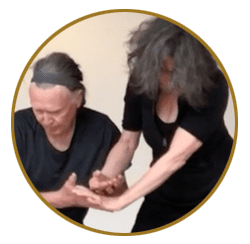About the Practices
Somatic Performer Workshops are jointly taught by Wendell and Erika as intensives of various lengths. See COURSE ARCHIVE for specific workshop descriptions. For each workshop we choose an aspect of the Body Mind Centering(R) material to research by applying experiential anatomy and developmental principles and concepts to improvisation (Viewpoints), physical acting ( Grotowski), dance making and personal movement research. The workshops offer methods of psychophysical and embodied research to support individual artists in creating original work across aesthetics and genres.
Developmental Movement is the study of the basic neurological patterns of locomotion and reflexive response. These patterns are inherent in the nervous system from both the phylogenetic (developmental) and ontogenetic (evolutionary) perspective. The fundamental patterns include both prevertebrate and vertebrate organization of the body and underlie complex movement and expression. These are the basic patterns of locomotion which underlie complex movement and whole body response .
Developmental Technique™ is a structured investigation of developmental movement exploring the basic patterns of locomotion, from pre-spinal, navel radiated states through crawling to vertical, embodied expression in space. The goals of the technique are to generate original movement vocabulary and to open the possibility of a wider and wider range of psycho-physical response within an interdisciplinary performance medium which embraces acting, dancing, abstract choreography, narrative and the play and scene form.
Experiential Anatomy is the study of all the major systems of the body. The somatic technique of experiential anatomy brings together a cognitive, conceptual understanding (basic anatomy and function) with personal and experiential research facilitated by movement, voice, breath and visualization. The specificity and detail of the Body-Mind Centering (R) approach gives us access to the variety of texture, emotional quality and expression inherent in the bodies tissues and organs.
Viewpoints: The work is taught in progressive stages; first identifying, through physical exploration, a primal vocabulary of space, time, shape, kinesthetic response, story (image) and emotion as both a field of focus for the individual performer and as compositional tools for the devising of performance work. As ongoing research into the Viewpoints pedagogy, we are striving to integrate a psycho-physical approach to acting (primarily through Stephen Wangh’s work based on Jerzy Grotowski’s approach), the experiential anatomy and developmental material derived from Bonnie Cohen’s work (BMC), and the mindfulness/awareness practices of meditation. We are building on our research in building comprehensive performance training at Naropa University (Contemporary Performance MFA 2004-2020) and Wendell's work at NYU's Experimental Theater Wing (1978-2003). Viewpoints improvisation and composition is viewed as a way to put all of these practices or techniques into a field of intensified expression or art making. We treat the Viewpoints as a container and instigator for individual and ensemble expression.
Mindfulness/ Awareness Practices are considered a core component of the Somatic Performer approach to training and expression. Based on extensive Buddhist research into the nature of consciousness and mind, these techniques are fundamental to the synchronization of body and mind and the development of presence, agency, and freedom for the performer.
Viewpoints and Somatic Technique can be viewed as underlying research tools for creating original work (devised work) or for fulfilling or embodying prescribed forms from choreographic concerns to character, scene, text or narrative arc.
